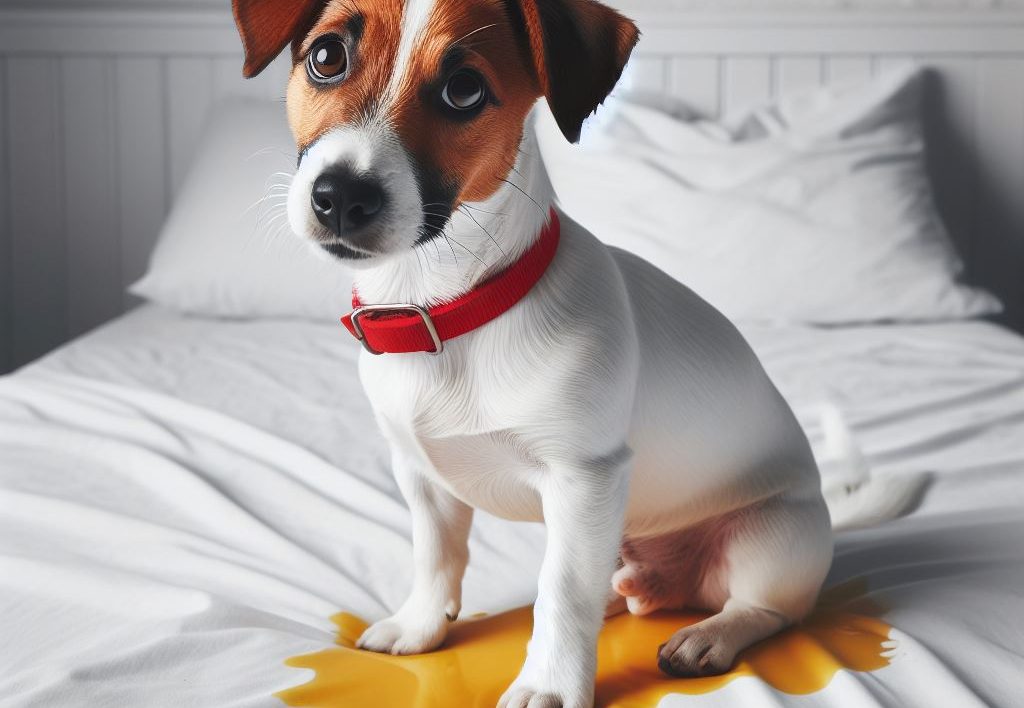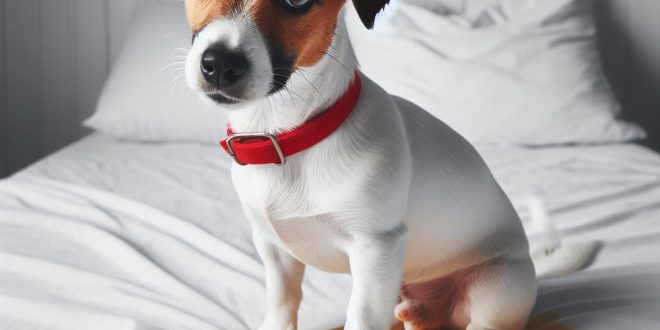
Why Did My Dog Pee On My Bed? – Discovering that your dog has urinated on your bed can be frustrating and confusing. Not only is it unpleasant to clean up, but you might also wonder why your dog would do such a thing. In this section, we will explore the reasons why dogs might choose to urinate on their owners’ beds and what you can do to prevent it from happening again.
Some common reasons why a dog might urinate on a bed include medical issues, marking territory and dominance, anxiety and stress, environmental factors, house training problems, and behavioral conditioning. By understanding these potential factors, you can better address your dog’s bed-wetting behavior and work towards finding a solution that works for both you and your furry friend.
If you’re currently dealing with a dog urinating on your bed, rest assured that you’re not alone. This is a common issue that many dog owners have faced, and with the right approach, it can be resolved. Keep reading to learn more about the possible reasons behind this behavior and how you can stop your dog from peeing on your bed.
SEO Keywords: why did my dog pee on my bed, dog urinating on bed, dog peeing on bed
Table of Contents
Possible Medical Issues
If your dog has suddenly started peeing on your bed and has never done it before, it could be due to an underlying medical condition. It’s essential to identify and treat any medical issues to prevent further bed-wetting incidents. Here are some common medical reasons why dogs might pee on beds:
| Medical Condition | Symptoms |
|---|---|
| Urinary Tract Infection (UTI) | Straining to urinate, frequent urination, blood in urine |
| Bladder Stones | Frequent urination, pain or discomfort when urinating, blood in urine |
| Diabetes | Increased thirst and urination, weight loss, lethargy |
If you suspect that your dog has a medical issue, it’s crucial to take them to a veterinarian as soon as possible. Your vet will conduct a physical exam, run some tests, and advise on the best treatment plan to manage the medical condition effectively.
If your dog’s bed-wetting behavior isn’t due to medical issues, it’s essential to look into other possible reasons and find ways to stop them from peeing on the bed. Stay tuned for the next section, where we explore territorial marking and dominance as a possible cause.
Marking Territory and Dominance
Dogs urinating on their owners’ beds may be related to their natural instinct to mark their territory. They use their scent to claim ownership of a particular space, and it can extend to their owners’ furniture and bed.
However, territorial marking can also be a sign of dominance. In some cases, a dog may urinate on their owner’s bed to assert their control over their owner. It’s essential to understand that this behavior isn’t an act of spite or malice.
If your dog is marking their territory or displaying dominant behavior through bed-wetting, it’s crucial to address this behavior. One solution is to limit your dog’s access to the bed or create a designated sleeping space for them. You can also reinforce rules and boundaries with your dog to establish your authority as the pack leader.
| Tip | Explanation |
|---|---|
| Use positive reinforcement training | Reward your dog when they display good behavior and redirect their attention when they try to mark or display dominance. |
| Regular exercise and playtime | A well-exercised and stimulated dog is less likely to display dominant behavior or engage in territorial marking. |
| Consult a professional trainer | Trainers can assess your dog’s behavior and offer customized solutions to address their specific needs. |
Remember that patience and consistency are key when addressing any unwanted behavior in dogs. With time and effort, you can redirect your dog’s behavior and prevent bed-wetting incidents.
Anxiety and Stress
Dogs can experience anxiety and stress, just like humans. Unfortunately, these emotions can cause dogs to urinate in inappropriate places, including on their owners’ beds. As pet owners, it’s essential to understand the signs of anxiety and stress in dogs to address the underlying problem, leading to bed-wetting behavior.
Identifying Signs of Anxiety and Stress in Dogs
It’s crucial to pay attention to your dog’s behavior, especially if they are urinating in unusual places like your bed. These are a few signs that your dog may be experiencing anxiety or stress:
- Panting, restlessness, or pacing
- Excessive barking or whining
- Destructive behavior, like chewing or digging
- Loss of appetite or excessive licking and grooming
Ways to Help Alleviate Anxiety and Stress in Dogs
As a pet owner, there are various strategies to help alleviate your dog’s anxiety and stress, including:
- Regular exercise to reduce stress and anxiety
- Create a safe, cozy space for your dog to retreat to if they feel stressed
- Provide your dog with plenty of mental stimulation to combat boredom
- Consider using natural remedies like pheromone sprays or calming music
- If anxiety or stress persist, consult with a veterinarian to discuss medication options
If you notice your dog peeing on your bed due to anxiety or stress, it’s crucial to address the underlying issue rather than punish your dog. Punishment can lead to increased anxiety and stress, exacerbating the problem. Instead, focus on providing your dog with a safe and secure environment and addressing the root cause of the anxiety or stress.
Environmental Factors
Changes in your dog’s environment can be a significant contributor to bed-wetting behavior. Dogs are sensitive to changes in their routines, surroundings, and family dynamics. As a result, environmental factors can trigger anxiety and stress, leading your dog to pee on your bed.
Some reasons why dogs may pee on beds due to environmental factors can include:
- Introducing new furniture
- Moving to a new house
- Adding new family members or pets to the household
- Changing feeding or walking schedules
- Altering sleeping arrangements
If your dog is experiencing changes in their environment, be patient with them as they adjust. Try to maintain as much consistency in their routines and surroundings as possible. Make changes gradually, so your dog has time to adapt to the new situation.
If your dog’s bed-wetting behavior continues despite efforts to manage environmental factors, it may be necessary to consider other underlying causes, such as medical issues or behavioral conditioning.
Stay tuned for the next section where we will discuss how house training and inconsistency can contribute to bed-wetting behavior and how to address it.
House Training and Inconsistency
If your furry friend is not properly house trained, they may have accidents, including on beds. Inadequate or inconsistent house training can cause confusion and frustration for your dog, resulting in them peeing in inappropriate places.
To prevent bed-wetting incidents, it’s essential to reinforce proper house training techniques consistently. Here are some tips:
- Establish a routine for feeding, playtime, and potty breaks to regulate your dog’s bladder.
- Supervise your dog closely, especially during potty breaks, to ensure they are doing their business in the appropriate place.
- Use positive reinforcement, such as treats and praise, to encourage desired behaviors.
- Be patient with your dog. Accidents will happen, and it’s important to clean them up thoroughly to remove any lingering scent.
If you’re struggling with house training, it may be helpful to consult a professional trainer or enroll your dog in obedience classes.
Consistency is key when it comes to house training. By providing clear boundaries and reinforcing positive behaviors, your dog will learn to associate peeing with appropriate areas and avoid urinating on beds or other furniture.
Behavioral Conditioning
Behavioral conditioning can contribute to dogs peeing on their owners’ beds. This happens when the dog learns that bed-wetting results in attention from their owners, even if it’s negative attention like scolding or cleaning up. This unintentional reinforcement can lead to a cycle of bed-wetting behavior.
To stop this behavior, it’s important to discourage any attention given to the dog when they pee on the bed. Instead, ignore the dog and clean up the mess without making a fuss. Provide positive reinforcement when the dog urinates in an appropriate location. This can be a gradual process, but consistency is key in breaking the cycle of bed-wetting behavior.
- To stop behavioral conditioning:
- Ignore the dog when they pee on the bed.
- Clean up the mess without giving attention.
- Provide positive reinforcement when the dog urinates in an appropriate location.
By breaking the cycle of unintentional reinforcement, you can help your dog learn appropriate behavior and prevent bed-wetting incidents.
Conclusion:
Understanding why your furry friend is peeing on your bed is crucial to finding effective solutions. By taking into consideration possible medical issues, territorial marking, anxiety, environmental factors, house training, and behavioral conditioning, you can address this behavior and work towards resolving it.
Remember, consistency is key when addressing any unwanted behavior in dogs. It’s essential to stay patient and use positive reinforcement to encourage appropriate behaviors. Seek help from a veterinarian or a professional dog trainer if needed.
Keep a Clean Environment:
Regularly clean the areas where your dog has peed, especially your bed and furniture. Use an enzymatic cleaner to eliminate the odor of urine and discourage your dog from peeing in the same spot again.
Be Loving and Supportive:
Remember that your furry friend is not trying to upset or annoy you by peeing on your bed. Showing love and support to your dog during their training process is crucial for their emotional well-being.
With patience and consistent training, your dog can learn how to behave appropriately and refrain from peeing on your bed.
 Treat For Dog – Brain Training for Dogs, Dog Training & Obedience Discover Treat For Dog and get your pup on the path to smarter, happier, and healthier living with brain training for dogs.
Treat For Dog – Brain Training for Dogs, Dog Training & Obedience Discover Treat For Dog and get your pup on the path to smarter, happier, and healthier living with brain training for dogs.




